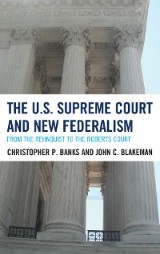Details

The U.S. Supreme Court and New Federalism
From the Rehnquist to the Roberts Court|
CHF 36.00 |
|
| Verlag: | Rowman & Littlefield Publishers |
| Format: | EPUB |
| Veröffentl.: | 13.07.2012 |
| ISBN/EAN: | 9781442218581 |
| Sprache: | englisch |
| Anzahl Seiten: | 362 |
DRM-geschütztes eBook, Sie benötigen z.B. Adobe Digital Editions und eine Adobe ID zum Lesen.
Beschreibungen
<span><span><span>Constitutional scholars Christopher P. Banks and John C. Blakeman offer the most current and the first book-length study of the U.S. Supreme Court’s “new federalism” begun by the Rehnquist Court and now flourishing under Chief Justice John Roberts. Using descriptive and empirical methods in political science and legal scholarship, and informed by diverse approaches to judicial ideology, from historical to new institutionalist, they investigate how the U.S. Supreme Court rulings have shaped the political principle of federalism. While the Rehnquist Court reinvorgorated new federalism by protecting state sovereignty and set new constitutional limits on federal power, Banks and Blakeman show that in the Roberts Court new federalism continues to evolve in a docket increasingly attentive to statutory construction, preemption, and business litigation. In addition, they analyze areas of federalism not normally studied by scholars such as religious liberty and foreign affairs. </span></span><br><span></span><br><span></span></span>
<span><span><span>Constitutional scholars </span><span>Christopher P. Banks and John C. Blakeman</span><span> offer the most current and the first book-length study of the U.S. Supreme Court’s “new federalism” begun by the Rehnquist Court and now flourishing under Chief Justice John Roberts. While the Rehnquist Court reinvorgorated new federalism by protecting state sovereignty and set new constitutional limits on federal power, Banks and Blakeman show that in the Roberts Court new federalism continues to evolve in a docket increasingly attentive to statutory construction, preemption, and business litigation</span></span></span>
<span><span><span>1. “A Notably Conservative Court?”</span></span><br><span><span>Plan of Book</span></span><br><span><span>2. Federalism Politics & Policies: Old, New, and Progressive Trends</span></span><br><span><span>Federalism at the Founding</span></span><br><span><span>The Evolution of Federalism Jurisprudence</span></span><br><span><span>The Founding and Nascent Nationalism</span></span><br><span><span>The Civil War, Dual Federalism and the Rise of Economic Nationalism</span></span><br><span><span>The Rise of the Democratic Welfare State Through Cooperative Federalism</span></span><br><span><span>The Judicial Role in New Federalism Politics</span></span><br><span><span>3. The Rehnquist Court, New Federalism, and States’ Rights</span></span><br><span><span>The Politics of New Federalism</span></span><br><span><span>Rehnquist New Federalism</span></span><br><span><span>Revolutionary and Counter-Revolutionary Trends</span></span><br><span><span>Dormant Commerce Clause</span></span><br><span><span>Process Federalism and Clear Statement Rules</span></span><br><span><span>New Federalism and the Constitutional Culture</span></span><br><span><span>4. Federalism, Justice Clarence Thomas, and Religious Freedom in the States</span></span><br><span><span>The Rehnquist Court and Religious Liberty</span></span><br><span><span>Justice Clarence Thomas and Establishment Clause Federalism</span></span><br><span><span>Historical Roots and Contemporary Approaches to Establishment Clause Federalism</span></span><br><span><span>Assessing Establishment Clause Federalism</span></span><br><span><span>The Constituencies of Establishment Clause Federalism</span></span><br><span><span>Congress and the Executive</span></span><br><span><span>Recent Developments in Federal Law</span></span><br><span><span>The Executive Branch</span></span><br><span><span>State and Local Governments</span></span><br><span><span>Interest Groups</span></span><br><span><span>Churches</span></span><br><span><span>Public Opinion and American Religious Life</span></span><br><span><span>Religious Liberty, Federalism, and the Roberts Court</span></span><br><span><span>5. Federalism and Globalization</span></span><br><span><span>Federalism, the Constitution, and Foreign Policy Preemption</span></span><br><span><span>Structural Shift from Above</span></span><br><span><span>Structural Change from Below</span></span><br><span><span>The U.S. Supreme Court Response</span></span><br><span><span>The Sidelined Court</span></span><br><span><span>The Confined Court</span></span><br><span><span>Flexible, Pragmatic Foreign Policy Preemption</span></span><br><span><span>Divided Court?</span></span><br><span><span>Conclusion</span></span><br><span><span>6. The Roberts Court and New Federalism</span></span><br><span><span>Federalism and the New Roberts Court Appointments</span></span><br><span><span>New Directions of Federalism in the Roberts Court</span></span><br><span><span>Statutory Construction Cases: Preemption</span></span><br><span><span>Constitutional Cases: The Eleventh Amendment and Commerce Clause</span></span><br><span><span>Conclusion</span></span><br><span></span></span>
<span><span><span>Christopher P. Banks </span><span>is associate professor of political science at</span></span><br><span><span>Kent State University</span></span><br><span></span><br><span><span>John C. Blakeman </span><span>is associate professor and chair of political science at the</span></span><br><span><span>University of Wisconsin-Stevens Point</span></span><br><span></span></span>
-
-
© 2024 media control GmbH
Alle Preise enthalten die gesetzliche Mehrwertsteuer. - AGB
- Impressum
- Datenschutzerklärung
- Kontakt
- FAQ
- Mein Konto
- Home
- Erweiterte Suche
- Widerrufsrecht
- Reader-Software
- Desktop-Ansicht
- Gutschein-Code einlösen


